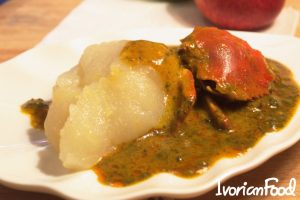A dish that is important to me would be my favorite meal: Placali. This is a West African dish originated from The Ivory Coast. My mom is from The Ivory Coast while my dad is from Guinea, so I was raised heavily in the traditions and cultures of both of these West African countries. The origin of this dish is one to be debated because online it says it originated from Ghana however, in reality, if you were to ask any West African they would state that Ivory Coast is its origin. Placali is a cassava dip in stew sauce that my family makes specifically. The cassava used to make the actual placali is grounded and beat with water which turns it into a thick paste that is a bit sweet. My mom makes her special sauce from okra and lots of spices. My family and I are extreme spice lovers. Every Ivorian, however, makes the sauce to the placali very different and I only knew this when I purchased a dish from an African restaurant. The only time my mom makes this dish is for holidays or when something great has happened in the family. Placali has become a celebratory dish for me and a dish of happiness. It’s always made with love and extreme joy in the moment.

The last time that my mom made placali was last month when my cousin graduated with her Bachelors from Fordham University. We had a big gathering and my mom brought her big dish of placali that everyone was anticipating. I enjoy placali serving this role in my life because I can never eat it and be in an unhappy state. This dish can cheer me up through anything because it’s effect on me has been imprinted since when I was young. Other natives see placali is just another dish they can eat whenever, but I don’t allow myself to eat it on the regular just because of its great significance to me.

Here is a picture of some of my family members on the day my older cousin graduated. This picture calls for some Placali.
____________________________________________________________________
Recipe:
Ingredients
- Cassava
- water
- lemon optional
Instructions
- Soak peeled cassava in water. You may use frozen cassava. Make sure it is fully covered in water. Leave to ferment covered outside for a couple of days. Change water daily.
- After about 4-5 days remove cassava, it should be soft by now. However, all the cassava does not get soft, don’t sweat it.
- Cut in small pieces to facilitate blending, if cassava is not too soft.
- Pulse or blend in batches with a little bit of water in a blender or food processor until puree.
- You may cook at this point or proceed with the next steps.
- Using a drainer squeeze out water from the cassava puree, this helps for storage .
- Wrap in portions and freeze until ready to use – unfroze before using.
- Place desired amount of fufu in a sauce pan on a medium heat. Add a little bit of hot water as needed. Keep stirring vigorously until cooked through. This takes about 10-15 minutes depending on the quantity.
- Then shape them into oval and wrap with thin plastic.

Hi, Fantagbe, I enjoyed reading about your favorite meal, placali. It’s good to know that the online sources are not accurate in pointing to its origin. Reading your post, I can imagine the happy ambience in the room as you and your family consume this spicy dish. I’m glad that you can always rely upon it to cheer you up; food sometimes has this amazing emotional impact that helps define who we are. This is a fairly well written essay, although it could do with better proofreading (for instance, “ground” instead of “grounded” in paragraph#1, “its” rather than “it’s” in paragraph#2). Your essay responds well to the prompt; however, it falls short of the required length (1-2 pages, single spaced)–perhaps you could talk about how your mom and her family started making placali and the role it played in their family tradition? Has it always been a celebratory dish? Or you may want to reflect upon how the dish has assumed such an important role in your own family, particularly as the two cultures (Ivorian and West African) interact with one another. The other thing I longed for (perhaps a bit selfishly) is more clarity regarding the photo of the dish–which part is placali or is the entree as a whole called placali–but of course it is of less significance, and it is a well-chosen pic!